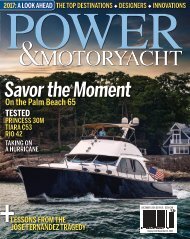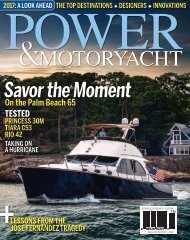rio
You also want an ePaper? Increase the reach of your titles
YUMPU automatically turns print PDFs into web optimized ePapers that Google loves.
RIO YACHTS 42 AIR<br />
The Art of<br />
Refreshment<br />
THERE’S SOMETHING IN THE AIR—THE RIO YACHTS 42 AIR—THAT BRINGS<br />
THE COOL WHEN THINGS HEAT UP. u BY ALAN HARPER<br />
This much deck space on a 42-footer?<br />
Reinvention of the status quo is<br />
what Rio Yachts is all about.<br />
50 POWER & MOTORYACHT / DECEMBER 2016 WWW.PMYMAG.COM WWW.PMYMAG.COM<br />
DECEMBER 2016 / POWER & MOTORYACHT 51
Test<br />
Notes<br />
CUSTOMIZATION<br />
has long been a<br />
hallmark for Rio<br />
Yachts. The better<br />
ideas that a buyer<br />
brings to the<br />
party, the more<br />
the company will<br />
incorporate.<br />
FROM POLISHED<br />
stainless steel<br />
to hand-stitched<br />
leathers and accents<br />
in “Tiffany<br />
Blue,” which Rio<br />
Yachts has taken<br />
on as an institutional<br />
color, the<br />
inte<strong>rio</strong>r finish of<br />
these boats is<br />
something to see.<br />
If you’re looking<br />
for a creative<br />
use of space, the<br />
42 Air Americas<br />
is a good place<br />
to start.<br />
THE BUYER<br />
of a boat from Rio<br />
Yachts may want<br />
to stand out a little<br />
bit. He may want<br />
something a little<br />
different. This<br />
boutique yard can<br />
accommodate<br />
most custom<br />
requests.<br />
PMY<br />
For an expanded gallery of the Rio 42, make your way over to<br />
www.pmymag.com/dec16.<br />
RIO YACHTS 42 AIR<br />
LOA: 43'5"<br />
BEAM: 13'2"<br />
DRAFT: 3'8"<br />
DISPL.: 35,000 lb. (dry)<br />
FUEL: 300 gal.<br />
WATER: 85 gal.<br />
TEST POWER: 2/435-hp Volvo Penta IPS600s<br />
OPTIONAL POWER: 2/370-hp Volvo Penta IPS500s<br />
TRANSMISSIONS: Volvo Penta IPS, 1.82:1 gear ratio<br />
PROPELLERS: Volvo Penta VP T4<br />
GENERATOR: Kohler, 13.5 kW<br />
WARRANTY: 5 years on hull and deck, manufacturer<br />
warranty on engines and equipment<br />
BASE PRICE: $740,000<br />
PRICE AS TESTED: $977,250<br />
I’m not saying Americans are demanding, but it’s nevertheless<br />
an interesting fact that, according to her manufacturers, a Rio 42<br />
Air fitted out to U.S. specification—which includes more powerful<br />
air-conditioning, a bigger generator, and an extra 12-inch<br />
monitor at the helm station, among va<strong>rio</strong>us other refinements—<br />
comes out ten percent heavier than the same boat built for the<br />
European market.<br />
Which perhaps explains why Rio chose to fit my test boat, the<br />
first one built for the U.S., with the larger of the two engine options—a<br />
pair of 435-horsepower Volvo IPS600s. On glassy seas off<br />
the Côte d’Azur at the tail end of summer, these proved more than<br />
adequate to push the boat through the 30-knot barrier. In fact, in a<br />
two-way speed trial—not that there was any tide to counteract, or<br />
even any wind during the hottest Cannes Yachting Festival anyone<br />
could remember—we averaged just over 32 knots.<br />
Rio Yachts might not have tracked across your radar before, but<br />
this family-run boatbuilder from northern Italy has carved out a<br />
solid reputation for its runabouts, weekenders, and sports cruisers<br />
for more than 50 years. While its main focus down the decades has<br />
been the domestic market, the company now seems determined to<br />
make a splash over on the more demanding side of the pond.<br />
It’s certainly taking the challenge se<strong>rio</strong>usly. European customers<br />
would generally expect three cabins in a 42-footer, but this first example<br />
of Rio’s new model was fitted out American style, with just<br />
the two. There’s much to recommend it. All boat layouts involve<br />
compromise, but there’s little of that in evidence here in the en suite<br />
double forward, which has a roomy head compartment, and a fullsize<br />
berth with 6 feet of headroom at its foot.<br />
The amidships cabin is also surprisingly practical, with a useful en<br />
suite, a small sofa on the port side, and cabinets to starboard, complete<br />
Her sleek lines and metallic finish will entice boaters looking for that sporty feel (top). The cockpit table (above right) rises from the deck (above<br />
left) to serve the aft seating area, a great way to make the most of deck space and up the ante in entertainment value for friends and family.<br />
52 POWER & MOTORYACHT / DECEMBER 2016 WWW.PMYMAG.COM WWW.PMYMAG.COM<br />
DECEMBER 2016 / POWER & MOTORYACHT 53
The natural light of that skylight will flood the space belowdecks, including<br />
a galley (left) and lounging space (far left). The forepeak stateroom<br />
offers a full queen and a yacht-worthy finish (left, bottom).<br />
sengers you set out with. A more useful innovation is the way the<br />
port section of the cockpit sofa pivots around to face forward—not<br />
to improve the view, but so it can sit inside the zipped canopy, the<br />
better to enjoy that high-spec, stateside air-conditioning.<br />
The fit and finish of the 42 Air are also aimed at the U.S. market,<br />
according to Rio, with high-quality plumbing fixtures, leathertrimmed<br />
door handles, stitched leather linings, and neat little features<br />
like the embroidered ‘RY’ logos on the upholstery, which all<br />
help to create a luxu<strong>rio</strong>us ambience that’s maybe a notch or two up<br />
from the average sports cruiser. Bamboo flooring is an unusual but<br />
attractive touch that also adds a little character.<br />
Unplugged from the boat-show pontoon, the sudden lack of 42,000<br />
Btu, American-style cooling power that we enjoyed belowdecks was<br />
apparent in the sweltering confines of Cannes’ Vieux Port that lent<br />
an element of urgency to our departure. In the airless conditions we<br />
badly needed to create our own breeze rather than deploy the curtains<br />
around the cockpit and crank up the air, and the Rio was only<br />
too willing to oblige.<br />
Lightly loaded as we were, with just three aboard and not much<br />
fuel, the moderate-vee hull was on the plane at about 2500 rpm, and<br />
from there onward provided a fun and responsive ride, with no vices<br />
and just the right angle of heel in the turns. It seemed especially<br />
comfortable at cruising speeds in the mid- to high-20s, and with big<br />
wheelhouse windows, sightlines from the helm were pretty good.<br />
It was also quite sensitive to fore-and-aft trim. Putting the tabs all<br />
the way down increased speed by a full knot—although such changes<br />
may be less marked with more fuel in the tanks and the boat’s<br />
center of gravity slightly farther forward.<br />
While 32 knots seemed an excellent result, it’s somewhat less than the<br />
top speed Rio claims for the 42 with IPS 600s. Part of that might be due<br />
to the heavier U.S. spec, but we did notice that the engines were about 50<br />
rpm down on their rated maximum of 3,500. So props with slightly less<br />
pitch might help reinstate the missing revs, add a little more speed, and,<br />
more importantly, ensure that the engines can reach their rated power<br />
even with stores on the boat or some late-season fouling on the hull.<br />
But if I hadn’t looked at the tachometers, I wouldn’t have realized<br />
that anything was amiss. The 42 Air felt right underway and proved to<br />
be a safe and enjoyable family cruising boat. It felt right in the harbor,<br />
too, with its luxu<strong>rio</strong>us fit-out, capacious stowage volumes, and the allimportant<br />
inte<strong>rio</strong>r space created by a generous two-cabin layout.<br />
There was another reason why it felt right, of course, once we got back<br />
from the sea trial. With the shore power plugged in again, that air conditioner<br />
was soon back up to full combat power. I didn’t want to leave. ❒<br />
Rio Yachts, 305-722-7200; www.ybiusa.com<br />
RIO YACHTS 42 AIR<br />
with a hinged and mirrored top to create a dressing table. Headroom<br />
over most of the berth is a perfectly reasonable 33 inches, while windows<br />
and an opening porthole on each side admit light and fresh air.<br />
With just two cabins, there’s plenty of space between them for a comfortable<br />
little saloon seating area opposite the galley on the port side,<br />
which has good counter area and plenty of stowage space. The saloon<br />
sofa slides out to create an extra berth, albeit one for shorter people—it<br />
measures 5 feet, 4 inches by 3 feet, 4 inches when extended—while the<br />
infill cushion has its own stowage slot under the galley sole.<br />
There are numerous other clever stowage solutions throughout<br />
the boat, from the dedicated glass and crockery cupboards in the<br />
galley to a useful little locker hidden away behind the companionway<br />
steps, which might not be especially accessible, but it still<br />
makes excellent use of otherwise wasted space. Best of all is the<br />
way the cockpit table rises electrically out of its own recess in the<br />
engineroom hatch. Of course this does mean that when the table is<br />
stowed, you’re walking on it, but for most owners that will prove a<br />
small price to pay for being able to make the table simply disappear<br />
when it’s not wanted. And naturally, in its half-way position, it fills<br />
in the L-shape of the sofa to make a large sunpad.<br />
A word about the cockpit sofa: that open corner looks pretty unusual,<br />
and there’s a reason for that. It has now dawned on Rio that<br />
what probably looked cutting edge on the drawing board is actually<br />
a pretty fundamental design flaw, and so future boats will have<br />
conventional seatbacks all around (thus filling in the open corner),<br />
to help ensure that you return to port with the same number of pas-<br />
RPM KNOTS GPH RANGE dB(A)<br />
600 4.3 0.90 1,290 65<br />
1000 6.4 2.38 726 65<br />
1400 8.2 5.81 381 70<br />
1800 10.2 11.09 248 74<br />
2200 14.5 21.13 185 75<br />
2600 19.5 26.42 199 76<br />
3000 25.4 35.93 191 77<br />
3450 32.1 43.32 200 78<br />
TEST CONDITIONS: Air temperature: 88°F; humidity: 60%; seas: 1';<br />
load: 87 gal. fuel, 85 gal. water, 3 persons, 250 lb. gear. Speeds are twoway<br />
averages measured with Garmin GPS. GPH taken via Volvo Penta<br />
display. Range is based on 90% of advertised fuel capacity. Sound levels<br />
measured at the helm. 65 dB(A) is the level of normal conversation.<br />
NOTEWORTHY OPTIONS: Volvo Penta IPS600 option ($45,000);<br />
48,000 Btu air-conditioning ($43,350); genset upgrade ($12,000);<br />
hydraulic swim platform ($22,500); 4-kW bow thruster ($6,750);<br />
custom galley ($6,850); additional 12-in Garmin MFD ($7,250).<br />
EDITOR’S NOTE: Since our test, Rio Yachts changed out the props and<br />
the trim tabs CPU, and reported a top speed of 35 knots at a fuel burn of<br />
45 gph with 119 gal. fuel and 87 gal. water, and three persons on board.<br />
54 POWER & MOTORYACHT / DECEMBER 2016 WWW.PMYMAG.COM WWW.PMYMAG.COM<br />
DECEMBER 2016 / POWER & MOTORYACHT 55





